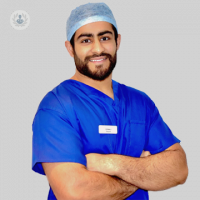Forehead reduction (hair line lowering)
Dr Fas Arshad - Plastic surgery
Created on: 02-28-2017
Updated on: 04-19-2023
Edited by: Jay Staniland
What is a forehead reduction?
A forehead reduction surgery is a cosmetic procedure that helps reduce the height of a person’s forehead.
Large foreheads may be due to hair loss, genetics or other cosmetic procedures.

Why is it done?
A forehead reduction can help balance the proportions of the face.
What does it involve?
A forehead reduction surgery is usually done under general anaesthesia. Local anaesthetic may be used to reduce bleeding and pain.
How do you prepare for a forehead reduction?
A plastic surgeon will help to guide you through the procedure. Preparation will usually include:
- The area of the forehead to be removed will be marked with a surgical skin marker, care is taken by the surgeon to ensure that the cut along the hairline will preserve hair follicles and nerves.
- Local anesthetic is used to numb the entire forehead, from the hairline to just above the brow.
- An incision is made where the marked area of the hairline and the forehead is. It is often referred to as the pretrichial incision. The connective tissue beneath the skin is separated.
- The top incision located along the hairline is pulled down to connect with the forehead incision. The gap is closed and the forehead appears to be shorter.
- The skin is stitched together in a way to minimise scar formation and is almost completely hidden by the hairline once hair grows back.
The surgery can usually take approximately 1.5 hours. It should be noted that although forehead reduction surgery reduces the height of the forehead, it may also change the shape of the eye brows.
Aftercare
Moderate pain and discomfort can be expected from 3 to 5 days. Patients can go back to their normal daily activities after 1 to 2 weeks but should avoid activities/exercise for 6 weeks including contact sports.
- patients may have to take two weeks off from work.
- 6 weeks off from doing any exercise.
- patients should sleep at a 45-degree angle for 2 weeks.
- full recovery can take 6 to 12 weeks.
It’s best to speak to your surgeon who will be able to advise you accordingly.
Alternatives to a forehead reduction
If a forehead reduction isn’t right for you, there are other options available including:
A brow lift – shifting the sking of the eyebrow area to lift the brows higher on the face.
Hair grafting – This involves taking hair from the follicles at the back of your scalp and transplanting them to the front of your hairline.







